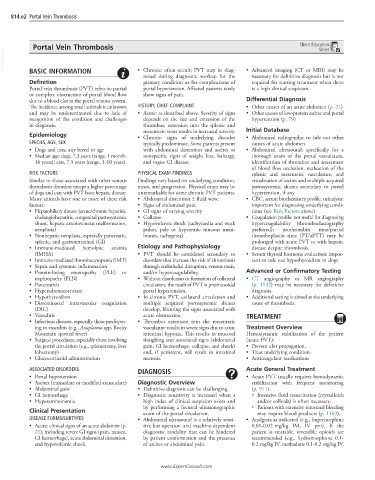Page 1616 - Cote clinical veterinary advisor dogs and cats 4th
P. 1616
814.e2 Portal Vein Thrombosis
Portal Vein Thrombosis Client Education
Sheet
VetBooks.ir
• Chronic: often occult; PVT may be diag-
BASIC INFORMATION
necessary for definitive diagnosis but is not
nosed during diagnostic workup for the • Advanced imaging (CT or MRI) may be
Definition primary condition or for complications of required for starting treatment when there
Portal vein thrombosis (PVT) refers to partial portal hypertension. Affected patients rarely is a high clinical suspicion.
or complete obstruction of portal blood flow show signs of pain.
due to a blood clot in the portal venous system. Differential Diagnosis
The incidence among small animals is unknown HISTORY, CHIEF COMPLAINT • Other causes of an acute abdomen (p. 21)
and may be underestimated due to lack of • Acute: as described above. Severity of signs • Other causes of low-protein ascites and portal
recognition of the condition and challenges depends on the size and extension of the hypertension (p. 79)
in diagnosis. thrombus; extension into the splenic and
mesenteric veins results in increased severity. Initial Database
Epidemiology • Chronic: signs of underlying disorder • Abdominal radiographs: to rule out other
SPECIES, AGE, SEX typically predominate. Some patients present causes of acute abdomen
• Dogs and cats, any breed or age with abdominal distention and ascites or • Abdominal ultrasound: specifically for a
• Median age: dogs, 7.3 years (range, 1 month- nonspecific signs of weight loss, lethargy, thorough exam of the portal vasculature,
16 years); cats, 7.5 years (range, 1-10 years). and vague GI disease. identification of thrombus and assessment
of blood flow occlusion, evaluation of the
RISK FACTORS PHYSICAL EXAM FINDINGS splenic and mesenteric vasculature, and
Similar to those associated with other venous Findings vary based on underlying condition, visualization of ascites and multiple acquired
thrombosis disorders except a higher percentage onset, and progression. Physical exam may be portosystemic shunts secondary to portal
of dogs and cats with PVT have hepatic disease. unremarkable for some chronic PVT patients. hypertension, if any
Many animals have one or more of these risk • Abdominal distention ± fluid wave • CBC, serum biochemistry profile, urinalysis:
factors: • Signs of abdominal pain important for diagnosing underlying condi-
• Hepatobiliary disease (acute/chronic hepatitis, • GI signs of varying severity tions (see Risk Factors above)
cholangiohepatitis, congenital portosystemic • Collapse • Coagulation profile: not useful for diagnosing
shunt, hepatic arteriovenous malformation, • Hypovolemic shock (tachycardia and weak hypercoagulability (thromboelastography
neoplasia) pulses, pale or hyperemic mucous mem- preferred); prothrombin time/partial
• Nonhepatic neoplasia, especially pancreatic, branes, tachypnea) thromboplastin time (PT/aPTT) may be
splenic, and gastrointestinal (GI) prolonged with acute PVT or with hepatic
• Immune-mediated hemolytic anemia Etiology and Pathophysiology disease despite thrombosis.
(IMHA) • PVT should be considered secondary to • Serum thyroid hormone evaluation: impor-
• Immune-mediated thrombocytopenia (IMT) disorders that increase the risk of thrombosis tant to rule out hypothyroidism in dogs
• Sepsis and systemic inflammation through endothelial disruption, venous stasis,
• Protein-losing enteropathy (PLE) or and/or hypercoagulability. Advanced or Confirmatory Testing
nephropathy (PLN) • Without dissolution or formation of collateral • CT angiography or MR angiography
• Pancreatitis circulation, the result of PVT is presinusoidal (p. 1132) may be necessary for definitive
• Hyperadrenocorticism portal hypertension. diagnosis.
• Hypothyroidism • In chronic PVT, collateral circulation and • Additional testing is aimed at the underlying
• Disseminated intravascular coagulation multiple acquired portosystemic shunts cause of thrombosis.
(DIC) develop, blunting the signs associated with
• Vasculitis acute obstruction. TREATMENT
• Infectious diseases, especially those predispos- • Thrombus extension into the mesenteric
ing to vasculitis (e.g., Anaplasma spp, Rocky vasculature results in severe signs due to acute Treatment Overview
Mountain spotted fever) intestinal hypoxia. This results in mucosal Hemodynamic stabilization of the patient
• Surgical procedures, especially those involving sloughing and associated signs (abdominal (acute PVT):
the portal circulation (e.g., splenectomy, liver pain, GI hemorrhage, collapse, and shock) • Prevent clot propagation.
lobectomy) and, if persistent, will result in intestinal • Treat underlying condition.
• Glucocorticoid administration necrosis. • Anticoagulant medications
ASSOCIATED DISORDERS DIAGNOSIS Acute General Treatment
• Portal hypertension • Acute PVT usually requires hemodynamic
• Ascites (transudate or modified-transudate) Diagnostic Overview stabilization with frequent monitoring
• Abdominal pain • Definitive diagnosis can be challenging. (p. 911).
• GI hemorrhage • Diagnostic sensitivity is increased when a ○ Intensive fluid resuscitation (crystalloids
• Hyperammonemia high index of clinical suspicion exists and and/or colloids) is often necessary.
by performing a focused ultrasonographic ○ Patients with extensive intestinal bleeding
Clinical Presentation exam of the portal circulation. may require blood products (p. 1169).
DISEASE FORMS/SUBTYPES • Abdominal ultrasound is a relatively sensi- • Analgesia as indicated (e.g., buprenorphine
• Acute: clinical signs of an acute abdomen (p. tive but operator- and machine-dependent 0.01-0.02 mg/kg IM, IV prn). If the
21), including severe GI signs (pain, nausea, diagnostic modality that can be hindered patient is unstable, reversible opioids are
GI hemorrhage), acute abdominal distention, by patient conformation and the presence recommended (e.g., hydromorphone 0.1-
and hypovolemic shock of ascites or abdominal pain. 0.2 mg/kg IV, methadone 0.1-0.2 mg/kg IV,
www.ExpertConsult.com

